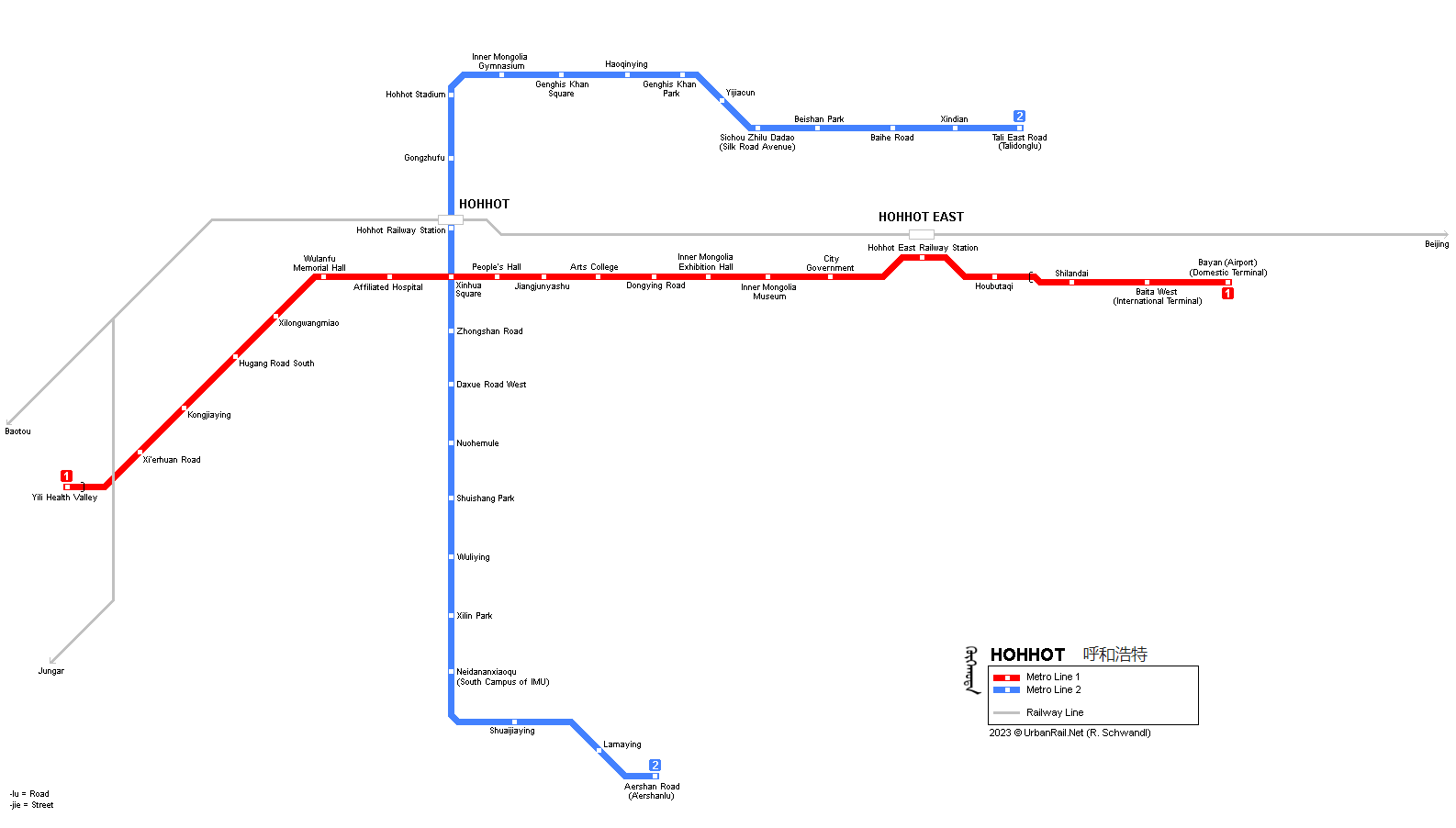
|
[ UrbanRail.Net ] [ Europe ] [ Americas ] [ Asia ] [ Africa ] [ Oceania ] [ News ] [ Books ] [ Links ] |
|
HOHHOT
|
| Inner Mongolia - China |

|
HOHHOT
|
|
Hohhot, the capital of Inner Mongolia in the north of China, some 400 km northwest of Beijing; 2 million inhabitants in urban area.
|
| Line 1 |
|
21.7 km with 20 stations, east-west line serving East Railway Station and Airport 29 Dec 2019: Yili Health Valley - Bayan (Airport) |
|
|
| Line 2 |
|
28.2 km with 24 stations, north-south line serving Hohhot Railway Station 01 Oct 2020:
Talidonglu - A'ershanlu |
|
|
|
Links
|
|
Hohhot Metro (Official Site) Hohhot Metro at Wikipedia
|
|
Photos
|
| Report |
|
In January 2020, Craig Moore reports from Hohhot: Encircled by the Daqing Mountains, Hohhot (pronounced Hoo-Hher-How-Ter) is a major centre of dairy production and its location result in the city being home to significant ethnic groups including Manchu, Hui, and of course Mongol. The Hohhot Metro opened in late 2019 and is operated by Hohhot Urban Rail Transit, the body also responsible for its financing, construction and management. The initial 23.4km line has 20 stations and runs from the airport (Bayan) in the east to Yili Health Valley in the industrial area beyond the Second Ring Road in the west of the city. At the airport the line runs on viaduct over the parking area in front of the terminal (not well signed in terminal) and near the airport road passing Shilandi to the south. The 2.8km elevation here is high before the drop underground where the line kinks north to Hohhot East Station. Returning to its main south westerly course, the line then runs below the main commercial road of Hohhot (Xinhua East Road/Xinhua Avenue). Unsurprisingly, this main section houses the busiest stations (Xinhua Square, Inner Mongolia Museum, Exhibition Hall and Dongying Road). At its western end, the line runs below Xinhua West Road as it crosses Dong He and the Second Ring before reaching the western terminus at Yili on a 0.4km grade alignment. Beyond this station is the huge stabling and maintenance depot. Services run from 0600-2200 at 10 min headways and the line takes 45mins to traverse. In many ways this Metro is redolent of Lanzhou in terms of alignment under the main commercial area, local ethnicities recognised in design etc, but it also differs in several ways. The elevated stations are huge affairs (Bayan has entrance level, wasted first floor and then platform level) and are pretty basic with side platforms, RTI etc. The underground stations have some unique street entrances and some variance in interior design but most have a standard template with broad pillars topped by broad coloured bands, slatted ceiling designs, island platforms with full screens and the usual information/security measures. Most stations also have interesting wall murals at ticket hall level. There are also some noteworthy stations of which Jiangjunyashu is the pick for its ornate ceiling, Xinhua Square has an impressive ticket hall ready for the Line 2 interchange (2020); and Inner Mongolia Museum Station has notable pillar designs. Given the alignment, this line is busy throughout and despite its young age it appears that locals have taken to having a metro very quickly. The stations are served by CRRC Changchun 6-car stock which has a smart black frontage and white sides with the exception of blue doors with ethnic patterning. The interiors are much like the stations in that there are very few stand-out features. The side seating has individual cushions which help with warmth on these cold days, there is a grubby green flooring and most trains have a back-lit sky image on the ceiling. There are no schematics on the trains and the strip maps are dynamic, shifting from language to language as does the audio (see below). The strip map is interesting in that it uses a Yurt image as station identifier and the red grab handles are not ring-like, but in the shape of an ornate C, with a gap at one side. Using the system is easy. The ticket machines are simple and have a multi-lingual option, dispensing card-based tickets (2-6 RMB). Nicely uniformed staff are numerous and friendly, wayfinding is excellent and as with everything on the system, there is a significant nod to the cultural history of the place. In addition to station designs, all signage is in Chinese, Pinyin (Latin) and Hudum Mongol (derived from the Uyghur alphabet). This is traditionally a vertically written script, but occasionally on the Metro it has to be written horizontally because of space considerations. Audio is in Chinese, Mongol and English. The system map at ticket hall level has been future-proofed to include Line 2, but there is no hard copy information available. Like Lanzhou, Hohhot is one of those out-of-the way cities that offers an interesting metro experience. The Hohhot system is fine and has some interesting stations and design elements, but, despite its very young age it is basic in places, and is already weathering. There are many peeling bits, grubby spaces and the external areas of the stations remain unfinished and unkempt. Given the climatic extremes of this city, this might become an issue. An interesting system with a few little flaws. |
2019 © Robert Schwandl (UrbanRail.Net)